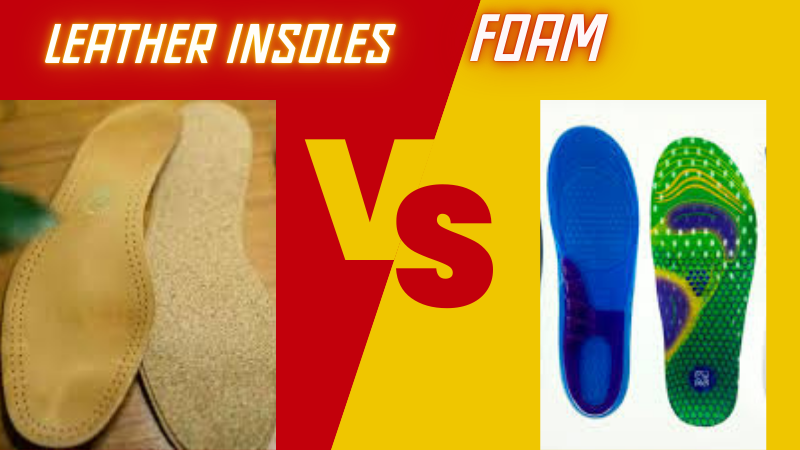Leather Insoles vs Foam (Comprehensive Guide)
Are Leather Insoles Better than Foam? Each of them has its advantages and drawbacks and therefore the choice greatly depends on the preferences of the particular buyer. In this blog post, I will be exploring the details of leather and foam insoles, comparing them and pointing at the strengths and weaknesses of each of them.
Characteristics of Leather Insoles
Some of the key benefits associated with this kind of insoles are that; leather insoles are relatively long-lasting, are also very airy, and can be marketed as having a very natural feel. These are normally produced from high-class animal skin and therefore a relatively hard-wearing, durable item.
Benefits of Leather Insoles
Are Leather Insoles Better than Foam? The Benefits are as follows:
1. Durability: Leather insoles are very long-wearing. As a result, they can endure heavy usage for a relatively long period and this will help in cutting down on cost in the long run.
2. Breathability: The material used is leather and this can breathe making the feet dry at all times unlike when using some synthetic products such as rubber. It is more so useful to those people who have extended-standing duties or those who live in hot areas.
3. Moisture Management: Leather insoles are able to breathe thus enabling them. Hence minimizing the chances of gaining those fungi and bad odor.
4. Comfort and Support: Leather insoles, in particular, tend to wear into the shape of the feet making it almost exclusively custom-made for your feet.
5. Aesthetic Appeal: Leather insoles give your footwear a classy look and feel and such insoles suit people with classy-looking shoes.
Drawbacks of Leather Insoles
Are Leather Insoles Better than Foam? The Drawbacks are as follows:
1. Cost: Foam insoles are cheaper than leather insoles since the development process used in making them varies in the quality of the material used.
2. Break-In Period: Some customers have complained that leather insoles take some time before they become comfortable and this can be inconvenient to uses.
3. Maintenance: Leather seats can get damaged easily and for that, they need constant proper cleaning and conditioning so that they don’t crack or go dry.
Understanding Foam Insoles
Characteristics of Foam Insoles
Foam insoles are available from different foam materials such as memory foam, EVA foam ethylene-vinyl acetate foam, and polyurethane foam. All these insoles have the special feature of cushioning and shock absorption which makes them soft to the feet.
Benefits of Foam Insoles
1. Cushioning: What’s more, foam insoles provide the best cushioning, and that makes them very suitable for those who have the barest padding and shock-absorbing needs. Apart from that, because of its structure, it may be rather helpful for people experiencing foot pains or those having plantar fasciitis.
2. Affordability: Still, foam insoles prove to be cheaper than leather insoles, which allows for the number of potential customers to be increased.
3. Immediate Comfort: Most foam insoles are, therefore, non-absorbing; people can wear the shoe comfortably without having to wear the insoles for a while to ‘shape’ to foot.
4. Lightweight: Foam insoles are also easily thin, and convenient being very light when incorporated in footwear.
5. Variety: Insoles come in the comfort of foam where one can choose an insole of more thickness, density and support.
Drawbacks of Foam Insoles
1. Durability: Foam insoles have lesser wear resistance than leather insoles and would therefore ideally require changing more often.
2. Breathability: The usage of foam makes breathability a problem in some instances since the material is less breathable when compared to leather most of the time.
3. Support: Foam insoles help in absorbing shock although they may lack the firmness and stiffness of leather insoles.
4. Compression: Foam insoles may wear out with time become thin and change shape and offer very little cushioning and support.
Comparing Leather and Foam Insoles
Comfort and Support
Are Leather Insoles Better than Foam? As for comfort, I still like leather material, at the same time, foam insoles shall also be taken into consideration. Leather is hard to wear but at the same time comfortable and conforms to the shape of the foot gradually. It will add support as the form fits and help to cut down on fatigue. On the other hand, the comfort provided by foam insoles comes in the form of a soft cushion which makes it comfortable immediately. They are very useful to those who need more cushioning especially when walking or those who have foot issues.
Durability and Longevity
As for durability, it is possible to mark the leather insoles as the winners. When well taken care of a pair of shoes can be used for a long time hence being economical after some time.
Breathability and Moisture Management
Leather insoles offer great advantages when it comes to the issue of breathability and moisture control. The matter is that they provide a free area for the airflow around your feet so it stays dry and comfortable there.
Cost and Accessibility
Foam insoles are cheaper when compared to leather insoles and therefore can be availed in the market to many consumers.
Aesthetic Appeal
Leather is often used for dress shoes some quality shoes and high-end shoes. Nevertheless, foam insoles don’t look quite the same although they complete the set of useful elements.
Choosing the Right Insole for You
Are Leather Insoles Better than Foam? Here are some factors to consider when making your choice: Here are some factors to consider when making your choice:
1. Foot Condition: If you have some pointed foot conditions like plantar fasciitis or arthritis then you should give preference to foam insoles with added cushioning and support.
2. Activity Level: Think of how active you are and the kind of shoes that you put on. Better quality foam insoles can be useful in a variety of cases – for physical training, or for prolonged standing. Leather insoles are appreciated for their versatility making them appropriate for casual wear as well as formal shoes.
3. Climate: Another advantage of wearing leather insoles is that people who reside in areas with high temperatures and high levels of humidity will appreciate the fact that this material allows their feet to breathe and does not make them sweat. Although they are cushioned, foam insoles are not necessarily as well-ventilated, however.
4. Budget: Another step is the determination of the budget and the amount of money one is willing to spend on insoles. Despite the time cost of the leather insoles being a little expensive to purchase as compared to the fabric ones, the cost in the long run is cheaper than the fabric ones due to their durability.
5. Personal Preference: Finally, it can be said that private choice is one of the key factors in the general equation. Some individuals witness that they like to wear the kind of insoles made of leather which offers a firm support and a natural feel to the feet and others like to wear the insoles which have foam stuff that help in providing the comfort feel to the feet.
Conclusion
Are Leather Insoles Better than Foam? Some considerations while deciding between leather insoles and foam insoles are; the requirement, the level of activity, weather conditions, the amount of money, and the individual’s feelings towards it all. When you get to know the features and uses of these types, you can make the right choice that will further improve your the comfort and health of your feet.



